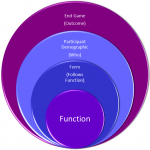How Skyscrapers and the National Great Teachers Movement are Connected
Ever heard of Louis Sullivan? How about the National Great Teachers Movement? Perhaps one of the hottest topics amongst those who function as GTM Practitioners - particularly those who have started to conduct and lead seminars - is that of seminar design. There are two primary components of structuring a seminar: 1) the actual lead facilitation of the event via introductions, set-ups, and timing of participant activities; 2) the physical, environmental, and logistical deployment of the event itself. These established roles of lead facilitator and seminar coordinator both set the tone and predisposed attitude of the seminar itself.
Louis Sullivan, an American Architect, considered by many as the creator of the modern skyscraper, was an influential architect. He was a mentor to Frank Lloyd Wright and an inspiration to the Chicago group of architects who have come to be known as the Prairie School. The quote Form Follows Function is attributed to him although he credited the origin of the concept to an ancient Roman architect.
In 1896, he wrote:
It is the pervading law of all things organic and inorganic, of all things physical and metaphysical, of all things human, and all things super-human, of all true manifestations of the head, of the heart, of the soul, that the life is recognizable in its expression, that form ever follows function. This is the law.
So it is with the design variance in a GT seminar. Form follows function. While most of the core components of the 3, 4, and 5 day seminar models are relatively established, they are always subject to change. There is no right way to design a seminar. For the characteristics of a GTS as David Gottshall originally defined, see his 1993 History & Nature of the NGTM document.
 Here is the visual I have in mind before I conduct ANY seminar, even ones that I have done before. In the case of seminar design, I don't start with the end in mind. With some projects, I'll do that knowing that I want to get to a specific place. However, in a GTS, that point in time is not only unknown & undefined, the result is highly individualized within the collective seminar experience so there's no way to know what will happen.
Here is the visual I have in mind before I conduct ANY seminar, even ones that I have done before. In the case of seminar design, I don't start with the end in mind. With some projects, I'll do that knowing that I want to get to a specific place. However, in a GTS, that point in time is not only unknown & undefined, the result is highly individualized within the collective seminar experience so there's no way to know what will happen.
This design is intentional so that while each seminar is the same, they can all be different and evolve in its own unique form. Trusting the process of design insures that the undefined outcome will be as it should be. This is one of those cosmic parallels to classroom instruction and the precise reason that some of my most productive courses I facilitated as an instructor notably had the fewest prescribed outcomes.
This approach can be frustrating at times because we as GT practitioners seem to want the written order and sequence of the way it's supposed to be. I did, especially when I first started running events. Well... in fact this information simply doesn't exist in the cosmic realm of great teachering. My motive was fear-based in that I didn't want to screw up. Even the well-known schedules of seminars that have been around for 20, 30, or 40 years should be questioned and viewed as a blob of clay on a potter's wheel.
Quintessential Element
One of the most artful and interpretive elements of conducting a seminar is in discerning the experience in which the participants are engaged. Interjections of humor, insertion of an anecdotal story, or just the sheer expression of intentional, but authentic interest in what is happening are all key to orchestrating a successful gathering. Give yourself permission to boldly connect and engage as a leader of the process.
Embrace your own level of confidence, shortcomings, and passions of process. Do all this, but have a transparent, tentative, plan of attack that runs about 4-6 hours ahead! Metaphorically speaking... the glass bowl.

Design-Point Considerations
These are some of the question variables I explore when choosing how I will create any given seminar.
Function
- What does the customer (institution) want? [This is as close to an *end game* question as I tend to get]
- CEU credit awarded?
- Leadership training
- Is GTS part of an internal mentoring / internal training module or program (i.e. new faculty)
- Is this seminar attached to a state or provincial faculty or SPOD (staff, program, or organizational development) association or initiative?
- Are multiple institutions involved in the seminar offering?
- Customer care focus? Organization learning tool?
- Organizational change agent (usually targeted and specific)?
- others
Form (conceptually viewed as global and/or holistic)
- Length of seminar?
- Instutional clusters?
- Open or closed enrollment?
- Venue?
- Meal and meeting time slots?
- Start time variance for the first gathering of participants (will we start at 10 AM? 1 PM? 4:30 or 5PM? 7 PM?)
- What kind of meeting space are we in?
- What if we are to meet 3x over 12 months? I did one of these and the seminar design components were forced into a new and creative sequence.
- Online component? Will papers be submitted electronically and not distributed on-site? Relationship of F2F interactions with online pre-seminar or on-site digital usage (if used)?
- How will participant assignments and homework impact design activities and venue parameters?
- others
Demographic
- cross-organizational
- teaching faculty / expereince levels / teaching fields
- counselors
- librarians
- credit / non-credit
- law enforcement agents
- support staff
- single department or division faculty
- academic leaders and/or administrators
- church leadership
- FT, PT, adjunct (sessional) faculty
- Great College model (president, trustees, students, sampling of all types & classifications of employees)
- duty station / multi-campus
- others
Outcomes
- enhanced student learning vis-à-vis enhanced faculty learning!
- satisfaction of administrative agenda or bucket list
- college organizational goals
- QEP & accreditation (artifacts)
- community college / university / early college familarity
- earned event
- faculty socialization
- grant fulfillment
- faculty reward & renewal
- college promotion & marketing (many facets)
- single & multi-college familarity
- others
Sources:
- https://en.wikipedia.org/wiki/Louis_Sullivan
- http://www.architecture.org/architecture-chicago/visual-dictionary/entry/louis-sullivan/
- http://digital-libraries.saic.edu/cdm/ref/collection/mqc/id/29596
- http://www.artic.edu/research/louis-sullivan-collection
- https://ngtm.net/wp-content/uploads/2015/03/History_Nature_NGTM_HiRez.pdf